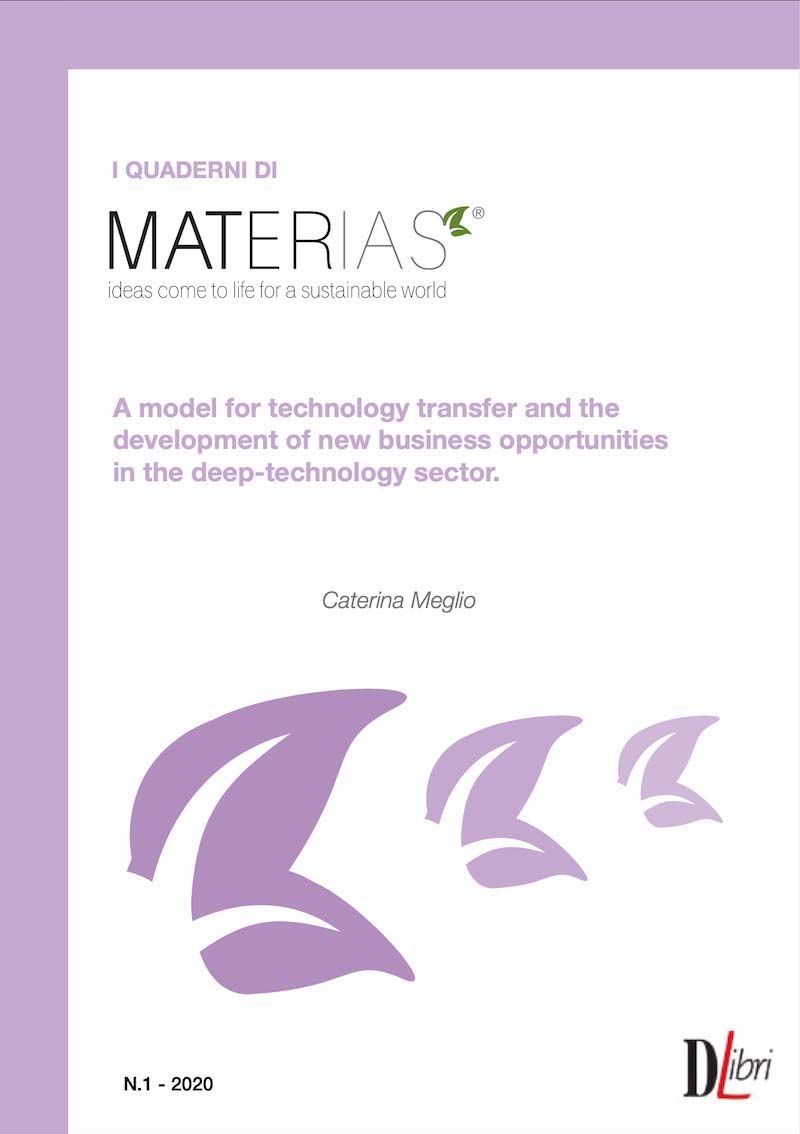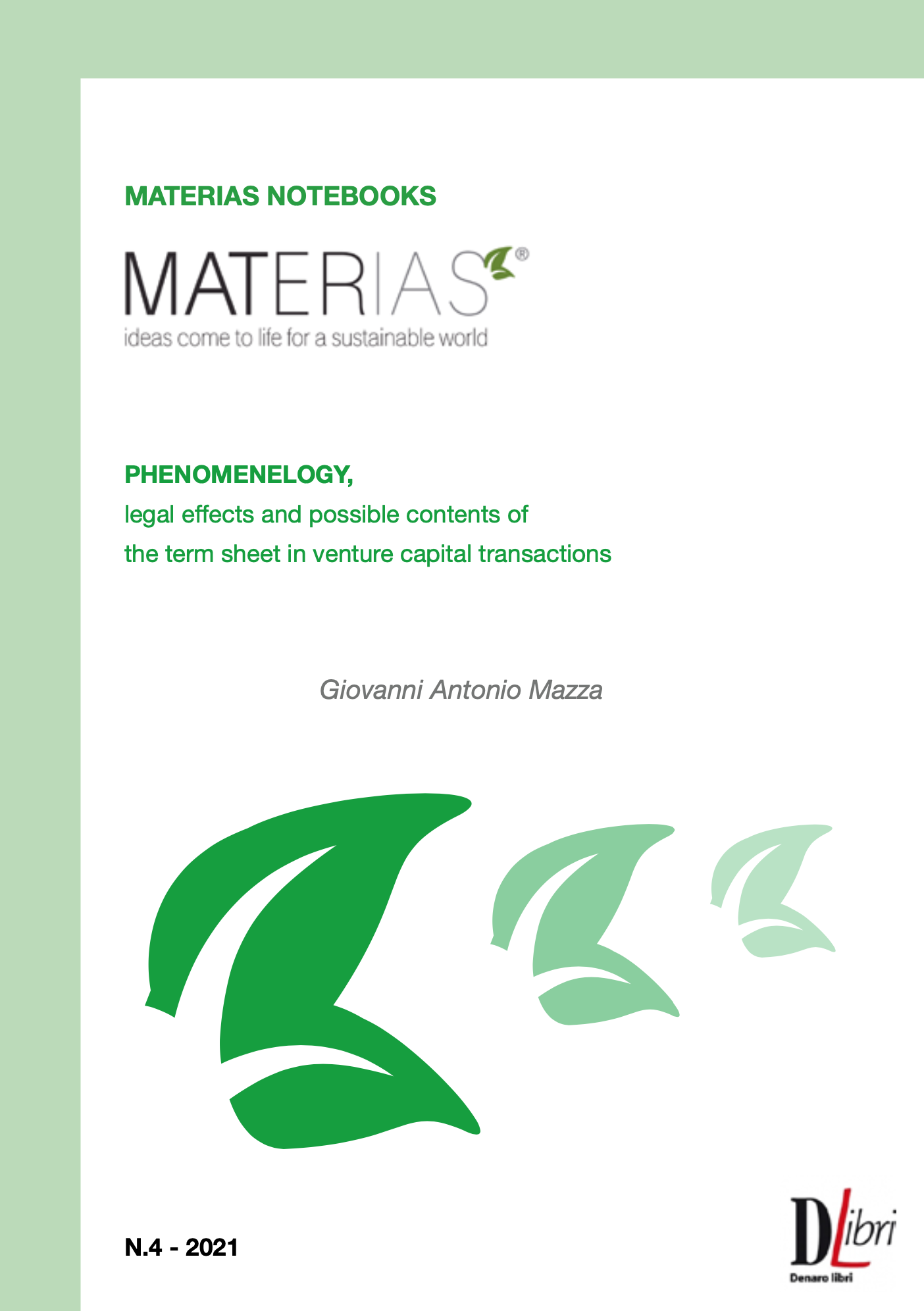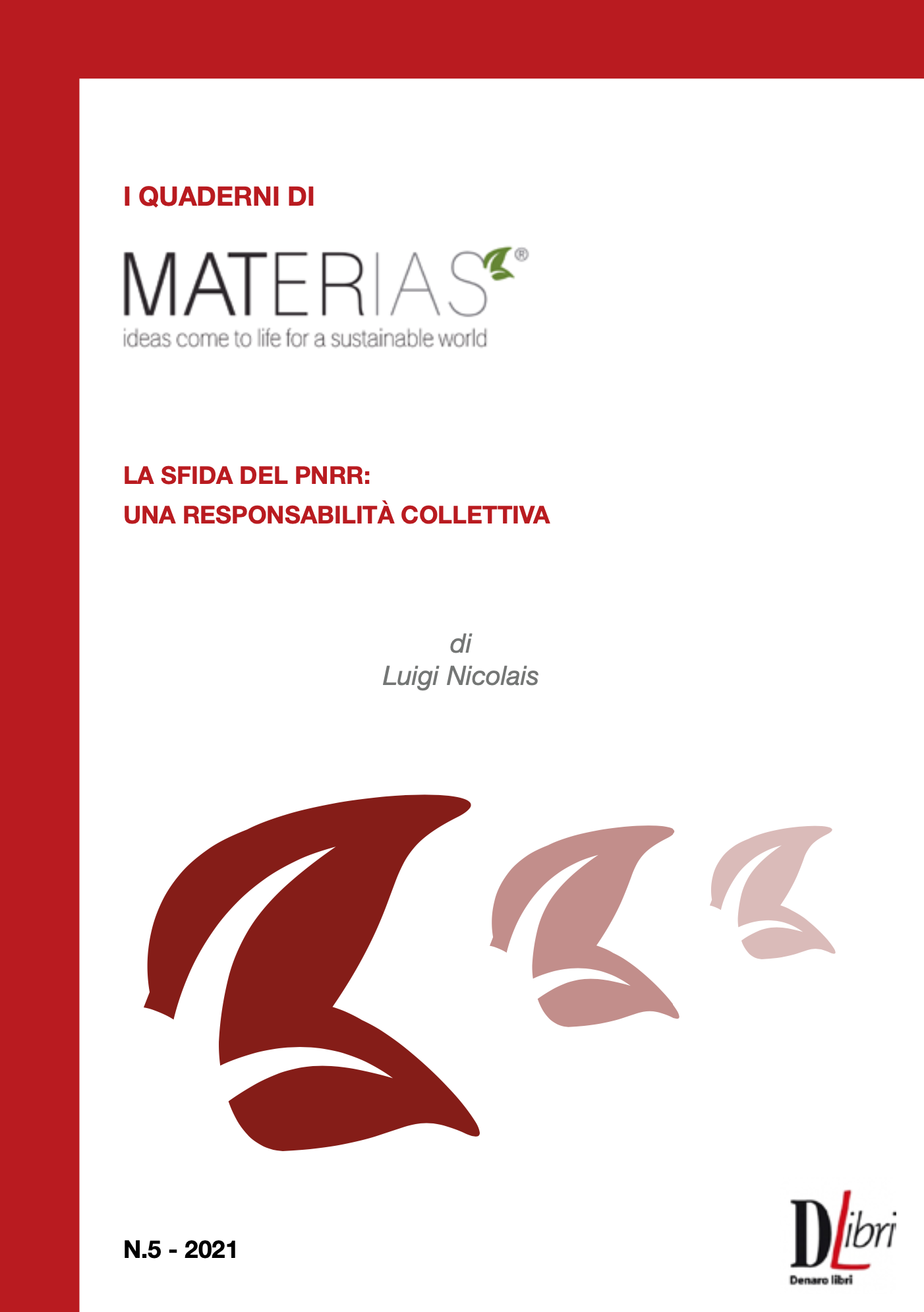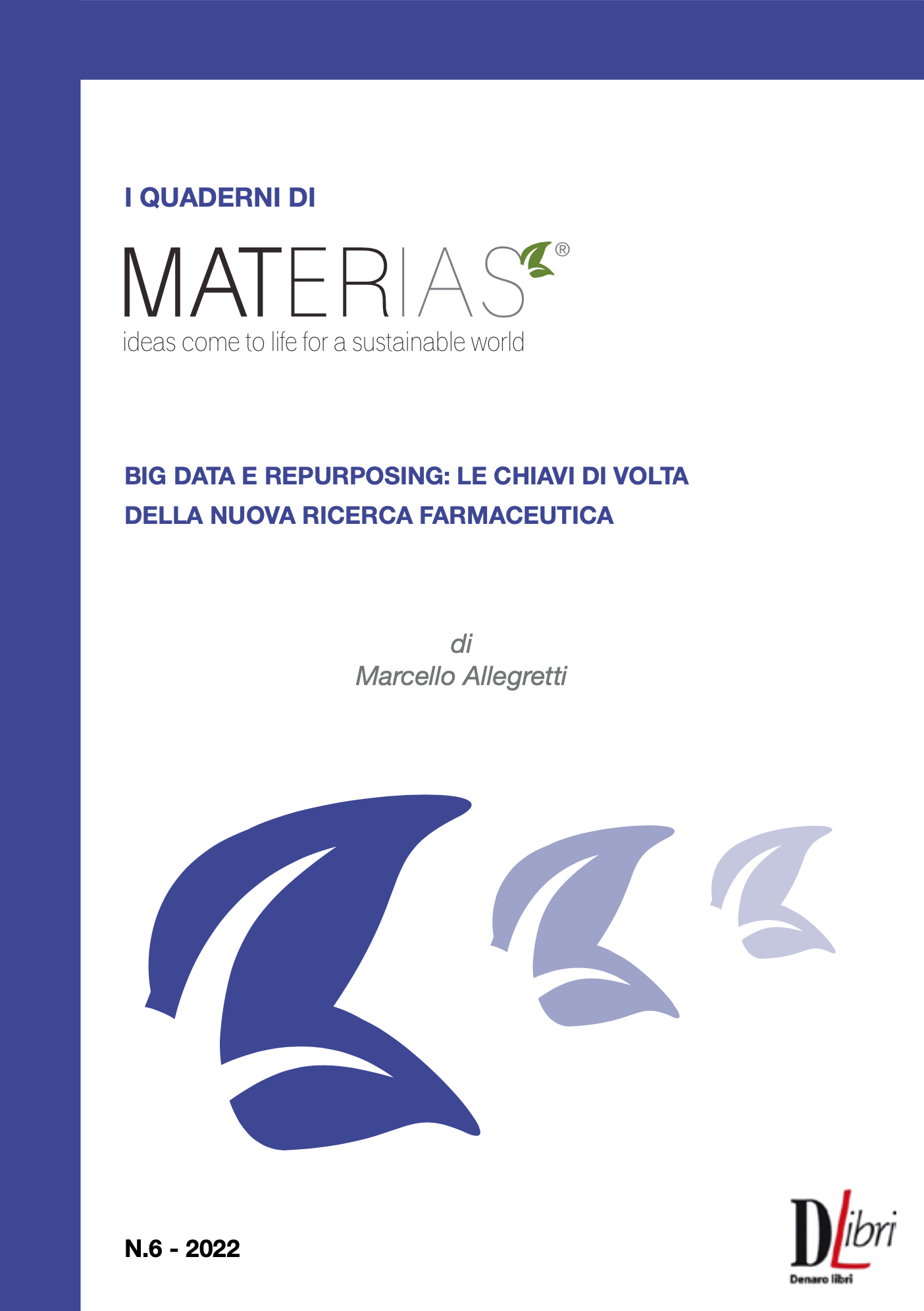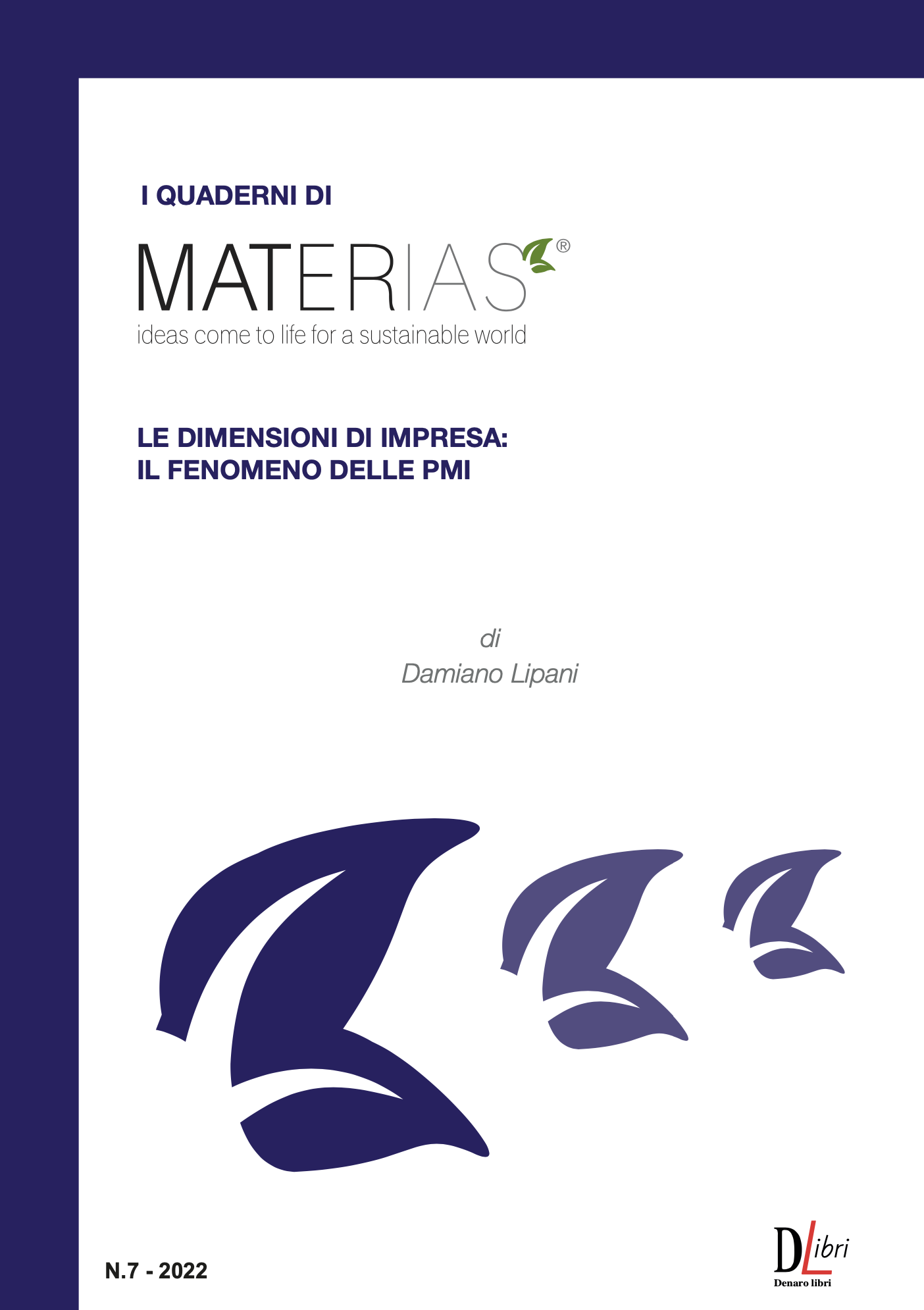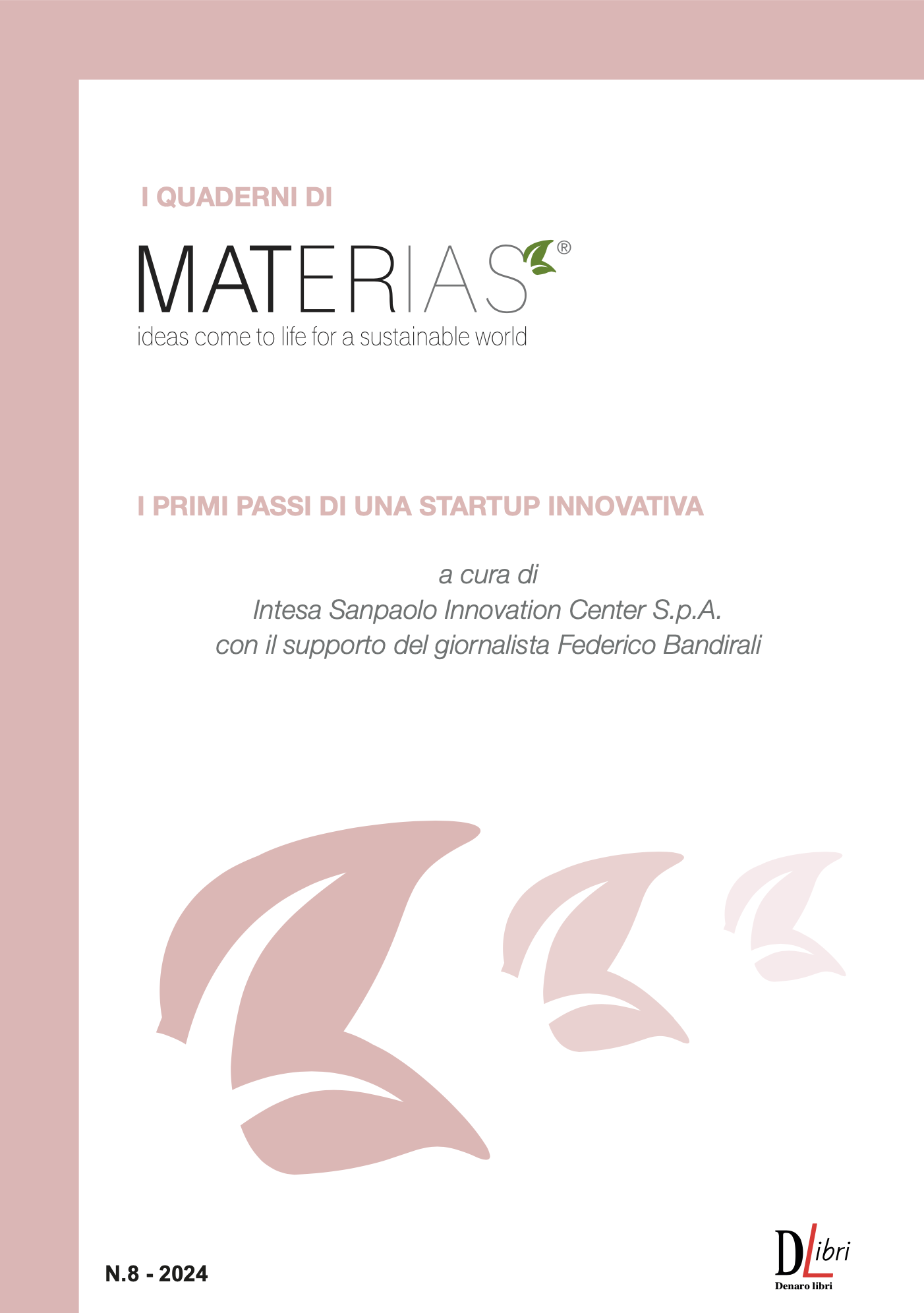N° 4
MATERIAS NOTEBOOKS
PHENOMENELOGY
Legal effects and possible contents of the term sheet in venture capital transactions
Giovanni Antonio Mazza
09 - 2021
ISBN: 9788899620097

Luigi Nicolais, President and founder of Materias
“Any time is a good time to start a company”.
This statement in times of pandemic could be wrong, but a careful analysis of the data shows a different scenario. The spread of the Covid-19 virus has paved the way for a new cultural revolution based on innovation and digital transition and Italy is doing its part. In this new issue of Materias Notebooks, we host Giovanni Antonio Mazza, Head of Extraordinary Operational Support at Intesa Sanpaolo. As we know, the scientific production of our country is at the top of the world rankings. In fact, the analysis of the performance of the world basic research shows that the scientific productivity of Italian researchers is at an excellent level: 3.5 articles published for every million dollars invested in research and development, thus recording levels of productivity and growth very similar to Canada and the United Kingdom. In addition, it is clear that Italy is a world leader in scientific production by a number of citations, especially in the Life Science sector.
However, analyzing the industrial impact of Italian scientific research on the country’s competitiveness system, it is clear that the transfer of research results is not among the best and most promising. But today something is changing, in fact, the intervention of venture capital and investment funds is representing significant financial leverage for Italy capable of making the system much more competitive on a global level. The investment of venture capital in innovative start- up equities promotes highly qualified job opportunities for young people and raises the level of industrial development. This form of investment is not only necessary, but it contributes to the qualified development of the national economy since venture capital investments in innovative start-ups promote high-profile job opportunities.
The sector, after a first natural phase of arrest in the first six months of the pandemic crisis and the difficulties of macroeconomic nature, is experiencing a moment of sustained growth in Europe, leading to a significant increase in invested capital. As highlighted by the recent 2020 Annual European Venture Report, 2020 transaction values grew by almost 15% compared to 2019 with a significant record amount of € 42.8 billion. Statista data show how the traditional historical-cultural heterogeneity that sees Great Britain as a leader among European countries with an investment of 13 billion euros and 5 new Unicorns in the year 2020 alone, is also confirmed in the value of investments in terms of quantity and annual delta. From a careful analysis of the data, the British dominance has been undermined by a dizzying increase in German- speaking countries with several investments grown by almost 60%. This summary picture, despite the obvious gap that exists with the US, shows how Europe, with its renewed strategy, represents a great opportunity for growth for the VCs. In fact, the InvestEU Fund, resulting from the Juncker Plan, between 2015 and 2020 disbursed more than 500 billion euros in support of European countries. The InvestEU Fund provides over 370 billion euros of public and private investments through a guarantee of the EU budget of 26 billion euros with a key contribution from the European Investment Bank.
Furthermore, during Digital Day 2021, 24 countries signed the international declaration of the EU Startup Nations Standards (SNS) to guide European start-ups through the application of the best practices underlying the most successful ecosystems in Europe and around the world, to increase the number of unicorns by 2030. The need for such an agreement stems from the fact that 36% of global startups are based in Europe but only 14% of global unicorns are located here. Investing in a startup involves very high risk. Most start-ups cannot overcome the so-called “valley of death”: the period in which the idea must become a product and the product must meet the market. At this stage of the development process, many costs are incurred with little income. In Italy, for example, there is a positive trend with financial institutions.
According to data from the Minister of Economic Development, the number of investments by banks in innovative startups has registered a positive trend. In the context of Open Innovation, the actors of the financial world are increasingly supporting the theory that not only the internal skills of the system are enough, but innovative solutions and skills are needed that comes from outside, in particular from startups, fundamental for the creation of value.
Financial institutions do not limit themselves to providing credit but carry out activities with a high intangible and qualitative value in terms of training, development and innovation, to bring start- ups to a stage of full maturity through constant managerial support. Financial institutions have created a truly dynamic ecosystem in which universities, research centres, and VC funds interact. All this, through a multisectoral and contamination approach, has led to an increase in start-ups in our south, which have become the beating heart of Italian innovation, confirming that “any time is a good time to start a company”.
In business practice, the conclusion (so-called closing) of a venture capital transaction (by which we mean, for this document, the acquisition of a stake, mostly minority, in a start-up by a financial investor with the aim of the related valorization and subsequent disposal within a medium-long term period) is usually preceded by a “ceremonial” of negotiation between the interested parties which is much longer and more complicated, the more complex and articulated is the regulation to which the investor potentially interested in “betting” on the business of the start-up is subjected. As will be pointed out several times in this paper, the approach of a so-called investor is quite different in this regard. “Informal” (variously defined in practice as a seed investor, business angel or private investor) concerning a so-called “institutional” investor (such as a closed-end investment fund, a bank or insurance).
The first phase of this “ceremonial” consists in the confidentiality agreement (non-disclosure agreement) which comes into line when the potential new investor, after the first informal contacts with the start-up and/or with the relative shareholders (so-called founders), you wish to have information on the start-up itself and its business that is not in the public domain or which in any case are not freely accessible to anyone. The stipulation of the non-disclosure agreement is essential when the start- up is asked for information on technical-industrial experiences or even simply commercial information that can have (and maintain) an economic value, provided that they are and remain secret (think, for example, to particular know-how or technical discoveries susceptible of patenting as an invention, but for which the relative application has not yet been formulated in the competent offices). information obtained and not to use it for purposes other than the evaluation of the terms and conditions of any investment transaction. Although the non-disclosure agreement is obviously mainly for the benefit of the start-up, cases are not uncommon (especially if the start-up is interested in an “institutional” investor) in which the same agreement defines the obligations that start-ups (and sometimes also their founders) must respect, such as, for example, the commitment not to disclose the news of the possible interest of the investor.
Among the confidential information that any investor needs to know in this initial phase certainly includes the business plan in which - basically - in relation to the business idea and the program of activities that the start-up will develop over a period of at least three years, the objectives to be achieved (in terms of turnover, economic result, etc.), the needs are indicated financial and related sources of coverage.
Once the investor has received, under the “aegis” of the non-disclosure agreement, the essential information to form a preliminary and general opinion about the quantum and quomodo of his investment, the negotiation comes alive. In the second phase, which is obviously crucial, the “key” aspects of the investment are discussed and primarily concern:
- the business plan of the start-up (here the expectations of “dilution” of the founders over time are also assessed in relation to the hypothesized subsequent investment rounds).
- the economic aspects of the transaction and, therefore:
- the enhancement of the start-up (in the event that the investment consists in the subscription of a capital increase or convertible equity financial instruments - provided that the issuing company qualifies as an “innovative start-up” -, the the core of the negotiation consists, in fact, in the determination, shared between the parties, of the so-called pre-money valuation of the company).
- the “price” requested from the investor.
- the “procedural” aspects of the transaction, including, mainly, the performance of due diligence, the resolutions of the corporate bodies of the start-up, any conditions precedent for the closing, the fulfillment of preliminary obligations to the work of the parties and anything else necessary for the implementation of the investment.
In this same phase, other clauses are also discussed, especially important from the point of view of the “institutional” investor, which, however, are intended to operate in the period following the closing, including, mainly:
- the legal / business representations and warranties and the related indemnity clauses.
- the agreements concerning the administration and control of the start-up (so-called corporate governance).
- any limits on the circulation of shareholdings in the start-up capital.
- the methods and timing of the disinvestment of the investment acquired by the investor (so-called exit), especially if it is an “institutional” investor.
In the case if the negotiation is successful, all these agreements are intended to find their place in a specific contract (so-called investment contract) stipulated between the founders of the start-up and the new investor (the stipulation of the investment is usually referred to as “signing”). In the context of signing or, more frequently, closing, the following procedure is also normally carried out:
- the amendment of the statute of the start-up to implement the protections and “privileges” required by the investor (in point, inter alia, of corporate governance, limits on the circulation of equity investments and exits).
- the signing of a shareholders’ agreement (even if it is not considered appropriate or it is not technically possible to include it in the statute of the start-up); as well as
- the stipulation of ancillary agreements, which are also very important (especially from the point of view of the founders), and which concern, inter alia, the remuneration, “stability” and non-compete obligations of the persons indispensable for the conduct of the business of the start-up (so-called key people) and any incentive programs.
If the founders of the start-up and the new investor immediately reach an agreement on all aspects of the transaction, whether essential or merely a corollary (which may well happen, especially if it is an investment by an investor “ informal “), it will be possible to proceed directly with the signing and, shortly, with the closing.
Otherwise, if the founders and the new investor, despite having agreed on some aspects of the transaction, require additional time to complete the related negotiation, in practice a specific agreement is drawn up, variously referred to as a “letter of intent”, “Minute or punctuation of contract”, “memorandum of understanding”, “statement of principles” or “heads of agreement” (hereinafter, simply, “term sheet” ), with which the same parties:
- mutually acknowledge:
- the main conditions and main terms of the operation on which a general agreement has already been reached between them (for example, the assumptions that lead to hypothesize a certain pre-money valuation of the start-up).
- their interest in continuing to negotiate with regard to everything that has not yet been defined.
- agree on the procedural methods with which to follow up on further negotiation, for example, by setting:
- subject of any due diligence that the new investor intends to carry out on the start-up.
- the terms within which the same investor undertakes to dissolve his reserve regarding the investment following the outcome of the same due diligence.
- i the maximum deadlines within which, in the event of a positive outcome of both the due diligence and the subsequent negotiation, respectively, to reach signing and closing.
- establish binding clauses of confidentiality (possibly confirming them, if they already exist), of applicable law (provided that it is a question of resolving a possible “conflict of laws”) and of jurisdiction / jurisdiction (for any disputes arising from the interpretation and / or from the execution and / or resolution of the term sheet).
If an “institutional” investor is involved in the possible investment in the capital of the start-up, the binding agreements of the term sheet most often include the exclusive obligation for the start-up itself (provided that the same is part of the term sheet) and founders (who undertake pursuant to Article 1381 of the Italian Civil Code, also due to the fact of the start-up, if it does not appear directly as part of the same agreement). In fact, it is very difficult for an “institutional” investor to accept the burden and, above all, the costs of due diligence and further negotiation without being protected from the risk that the start-up and / or founders may simultaneously solicit , initiate, continue or conclude, directly or indirectly, negotiations with third parties concerning the stipulation of agreements which have as their object operations on the capital of the same start-up.
Always if an “institutional” investor is involved in the possible investment, the stipulation of the term sheet is normally requested by the same investor in order to have in writing the essential terms and conditions of the envisaged investment to be subjected to the authorization of the relative decision-making bodies, also as regards the performance of due diligence. For this reason, it happens in practice, especially if the possible investor in the start-up is a closed-end investment fund specialized in venture capital, that the stipulation of the term sheet is preceded by an “expression of interest” which is a sort of light term sheet proposed by the fund’s investment team and not yet approved by its investment committee. Only at a later stage, provided that the negotiation has proceeded positively, is the decision to authorize the stipulation of the (actual) term sheet and the due diligence costs submitted to the investment committee of the fund.
Anyone who is to stipulate a term sheet must have in mind, for the avoidance of misunderstandings and, above all, of responsibility, what is the legal qualification and what are the effects of that agreement that is going to sign. Under the name of “term sheet”, in fact, in practice we find cases that are actually very different from each other: they range from mere gentlemen’s agreements (in which the parties - purely and simply - mutually acknowledge their willingness to enter into negotiations in view of an agreement having a certain object, without however going down to consider the relative terms and conditions) up to agreements that govern in detail all the elements of a given transaction, subjecting the effectiveness of the same agreements to a condition (not merely) potestative affixed in the interest of only one of the parties (such as when, for example, it is envisaged that the effectiveness of the commitments undertaken by an “institutional” investor is subject to the approval of the transaction by the relevant decision-making bodies).
The term sheet, even when - as is usually the case - expressly qualified as “non-binding” for the purpose of completing the transaction contemplated therein, is still a source of legal obligations for the parties who sign it.
In the first place, the term sheet normally provides, as mentioned, specific bin-ding agreements, the violation of which entails the onset of a real contractual liability, with consequent obligation for the defaulting party, in the absence of proof that the ‘’ non-fulfillment or delay in fulfillment was determined by the impossibility of the performance deriving from a cause not attributable to him, to compensate the damage suffered by the counterparty, i.e. the loss (so-called emerging damage) and the loss of earnings (so-called loss of profit) as are immediate and direct consequence of the non-fulfillment (with the clarification that, if the non- fulfillment or delay in the fulfillment does not depend on willful misconduct of the obliged party, the compensation is limited to the damage that could have been foreseen in the time in which the obligation arose).
However, even in relation to the agreements expressly qualified in the term sheet as “non-binding” there is the (inalienable) obligation established by art. 1337 of the Civil Code, according to which “The parties, in carrying out the negotiations and forming the contract, must behave in good faith”.
In fact, anyone who, after the stipulation of the term sheet, has given rise to a reasonable expectation in the counterpart that the negotiations would have been concluded positively, is in contravention of this obligation, becoming liable to pre-contractual liability, suddenly and unjustifiably withdraws from the negotiation or refuses or claims to modify previously accepted agreements (for example, the quantification of the start-up’s pre-money valuation) or take any other conduct that qualifies as “contractual bad faith”.
As established by the jurisprudence of legitimacy:
- to the hypotheses of pre-contractual liability pursuant to art. 1337 of the Italian Civil Code art. 1223 cc, with the consequence that the compensation must include both the loss suffered and the loss of earnings, provided that it is in immediate and direct relationship with the breach of the trust, and not of the contract, thus consisting of the resulting damage in the expenses incurred and the loss of profit. on missed job opportunities, while what would have been due under the unfinished contract remains, in any case, excluded (Cass. n. 27648/2011).
- the pre-contractual liability provided for by art. 1337 of the Italian Civil Code may derive, in addition to the unjustified breaking of negotiations, also from the violation of the obligation of mutual loyalty, which entails a duty of completeness of information about the real intention to conclude the contract, without any change in circumstances being capable of legitimizing the reticence or
the malicious omission of relevant information during the prosecution of the negotiations aimed at stipulating the shop (Cass. n. 6526/2012).
- the rule laid down by art. 1337 of the Italian Civil Code does not refer only to the hypothesis of unjustified breaking of negotiations, but has the value of a general clause, the content of which cannot be predetermined in a precise manner and implies the duty to treat fairly, refraining from malicious or reticent behavior and providing the counterpart with any relevant data, known or known with ordinary diligence, for the purpose of stipulating the contract. It follows that the violation of the obligation to behave in good faith in the conduct of negotiations and in the formation of the contract is relevant, not only in the event of unjustified breakdown of the negotiations and, therefore, of failure to conclude the contract or conclusion of an invalid contract. or ineffective, but also in the event that the contract concluded is valid and, nevertheless, is detrimental to the party that is the victim of the misconduct of others (Cass. n. 23873/2013).
The prospect of a possible pre-contractual liability must therefore be taken into serious consideration, given that, especially when the party to be compensated is an “institutional” investor, the expenses incurred by the same for hiring consultants for negotiation and due diligence they can easily amount to several tens of thousands of euros. Having made these necessary premises on the phenomenology and on the legal effects of the various species of agreements included in the genus of the term sheet, it is now possible to consider, necessarily synthetically, the content (according to the id quod plerumque accidit).
Also, to simplify the presentation, the usual table-like structure adopted for the drafting of the term sheet will be taken into consideration below, mentioning in the first column, on the left, the various sections of the term sheet (distinguished by topic) and in the second column, on the right, some brief editorial notes. The structure and the most frequent clauses of a term sheet relating to a hypothesized investment transaction will be considered which:
- is carried out through the subscription of a capital increase by a person who is not already a shareholder of the start-up.
- concerns a start-up established in the form of a limited liability company.
This section contains the details of those who subscribe to the term sheet; in the case of legal persons, the data of the respective representatives have also indicated and by which “powers” they act. Sometimes the start-up also appears between the parties, in order, among other things, to:
- become a “creditor” of the confidentiality obligation assumed by the new investor.
- undertake on one’s own commitments to enable the investor to carry out the due diligence.
- undertake any exclusive commitments on its own.
- reserve the right to declare to profit from the stipulations in his favour according to art. 1411, paragraph 2, of the Italian Civil Code, provided that the term sheet does not expressly exclude this right.
In this section:
- the target of the operation is identified, i.e., the start-up with a concise representation of the related activity.
- reference is made:
- to the shareholder structure of the start-up, with an indication of the personal details and the respective shareholding of the founders.
- the current statute of the start-up.
- the existence or not of shareholders’ agreements between the founders.
- the business plan adopted by the start-up’s administrative body.
- the existence of a negotiation between the parties relating to the possible investment in the start-up by the new investor is acknowledged.
- it is clarified that:
- the term sheet is not binding to complete the transaction described therein, except for certain clauses expressly identified (usually, exclusive, confidentiality, applicable law and exclusively competent court).
- enforceable obligations of the parties to complete the transaction described therein will arise only if and when (in any (case within the term of effectiveness of the term sheet) definitive agreements (final and binding) are stipulated, such as the investment contract, shareholder agreements, etc.
- the investor specifies the assumptions on which his interest in his investment in the start-up is based.
In this section, the amount of the pre-money valuation of the start-up is expressed in numerary (or, at least, indicated the algorithm to quantify) based on which the percentage of participation obtained by the investor for the execution of the hypothesized contribution.
Most of the time the agreement between the new investor and the founders on the pre-money valuation of the start-up presupposes that the business plan has also been defined that must be implemented by the same company after the closing (and which is frequently specific attachment to the term sheet).
The essential elements of a venture capital operation consist of:
- the amount of the capital increase, in terms - respectively - of nominal contribution and possibly of premium.
- the subject of the investor’s contribution (in cash and / or in-kind).
- the timing of the envisaged conferment, if any divided into tranches about the occurrence of conditions precedent, for example, the achievement of certain results (so-called milestones) and/or the expiry of a given term.
- the so-called share fully diluted (on point v. below) of the shareholding assigned to the investor in exchange for the expected contribution.
By “fully diluted” share we mean the percentage of capital represented by the shareholding assigned to the investor and which is calculated considering the exercise of all subscription and/or capital conversion rights recognized by the start-up and still exercisable (so-called outstanding), including the option rights for the subscription of new shares relating to a previously approved share capital increase (for example, to service the conversion of equity financial instruments or the exercise of assigned stock options to key people as part of the related incentive plan).
The more the new investor and founders will be able to advance in the preliminary negotiations, the more these elements will be defined.
In any case, if the due diligence activity has not yet been started or completed, the new investor will obviously reserve the right to confirm (or modify) the “numbers” of the operation, once the results of the due diligence have been evaluated. (And once the favorable resolution of its decision-making bodies has been obtained).
If the parties have already substantially defined the economic terms of the transaction, the term sheet also considers:
- the formalities of the start-up bodies necessary to arrive at the resolution of the capital increase offered for subscription to the investor.
- the characteristics of the capital increase and the final deadline for its subscription; most of the time the capital increase is “reserved” for the investor, in the sense that the option right of the founders is excluded (on point see, however, below); however, it will have to be established whether the capital increase will be divisible, indivisible, whether progressive or not;
- the commitments of the founders (in terms of voting at the shareholders’ meeting and any waiver of the options right, if the planned capital increase is not “reserved”).
- the intended use that the start-up will make of the contribution received.
It is worth it because the resolution of a capital increase with the exclusion of the option right determines in the s.r.l., according to art. 2481-bis, paragraph 1, the second part of the Italian Civil Code, the right of withdrawal for shareholders who have not consented. This can be a hindrance for many venture capitalists to invest in start-ups that, after launching a capital raising campaign through crowdfunding platforms, find themselves having many partners.
As mentioned, if an “institutional” investor is involved in the possible investment, the term sheet usually establishes the exclusive obligation for the start-up and/or founders.
Most of the time the term sheet is quite generic as regards the other aspects of the investment operation, limiting itself to establishing the essential guidelines that the parties will have to take into account in the subsequent negotiation phase. In particular, it refers to:
- the legal / business representations and warranties and the related indemnity clauses for the benefit of the investor.
- the clauses relating to:
- limits on the circulation of equity investments,
- anti-dilution,
- corporate governance and deadlock, - key-people.
- liquidation preference.
- pay-to-play;
- stand-still;
- exit.
In the term sheet, it is usually established, according to an unstoppable trend, that the definitive agreements concerning the topics referred to in the previous point (ii) are preferentially placed, to the maximum extent permitted by the legal system, in the statute of the start-up (mostly with recourse to the so-called “particular rights” according to Article 2468, paragraph 3, of the Italian Civil Code). It is therefore envisaged in the term sheet that the same statute will be specifically modified in the context of the closing.
Moreover, the statutory clauses (for which the relative advertising is duly fulfilled with registration in the business register):
- they are erga omnes effective and, therefore, not only towards the parties that took part in the foundation of the company but also:
- whoever, by succession Mortis causa, succeeds in the ownership of a shareholder’s share.
- of those who subscribe to new shares of the same company at the time of the paid capital increase); and any other third party (such as, for example, the creditors of a company).
- they have real effectiveness (in the sense that, in the event of their violation, they are - normally - subject to specific execution).
The shareholders’ agreements, on the other hand:
- they are effective inter partes and, therefore, they are not susceptible - in principle - to being opposed to anyone who, by succession Mortis causa, takes over the ownership of the shareholding of one of the relative contracting parties.
- they have a purely mandatory effect.
For s.r.l., unlike what is established for s.p.a. (and for the companies that control an s.p.a.), it is not legally required that the shareholders’ agreements, if stipulated for a fixed term, have a maximum duration set mandatorily by law.
The shareholders of an s.r.l. (which does not control an s.p.a.), they can therefore agree a term of duration of the shareholders’ agreements even greater than five years (a term applicable to s.p.a. and to companies that control an s.p.a.), however, it must be borne in mind that:
- an excessively long term could qualify the shareholders’ agreement as indefinite, with a consequent right of withdrawal for each member based on general principles.
- if the ultra-five-year shareholders’ agreement contains agreements for which the law establishes, with a mandatory rule, a maximum duration that is shorter than the “general” duration of the agreement itself, a specific duration must necessarily be provided for the aforementioned agreements, differentiated from the “general” one and in any case respectful of the time limits prescribed by law (consider, for example, the provisions of article 1379 of the Italian Civil Code, concerning the prohibition of alienation).
It should also be borne in mind, with specific reference to s.r.l., that the instrument of the particular rights is referred to in art. 2468, paragraph 3, of the Italian Civil Code (which, according to the now dominant interpretation in practice, can also concern different and additional areas concerning the administration of the company and the distribution of profits) allows configuring as statutory rights most of the “privileges” normally required by the true capitalists.
Shareholders’ agreements, especially if they refer to an s.r.l., are therefore destined by now to play the role of residual “container”, as in cases where one of the following circumstances occurs:
- some agreements are to be kept confidential.
- it is a question of implementing an agreement which, if inserted in the statute, would be null and/or ineffective due to contrary to a mandatory rule or an essential “typological profile” of the start-up.
- you want to avoid that the modification of the statute of the start-up gives rise to the right of withdrawal.
Below is an overview, inevitably extremely concise, of the agreements that are most frequently taken into consideration in a term sheet.
5.1.1 Lock-up and impediments to the transfer Mortis causa of the shareholdings
Most of the time the “institutional” investor asks that the shareholders of the start-up (especially in the case of key people) undertake not to put in place any inter vivos transfer deed for any reason whatsoever (including as a guarantee) of the respective shareholding for a given period of time (so-called lock-up) and agrees to also be subject to the same constraint. However, specific exceptions to lock-up operations are often provided that allows founders to monetize small shares of their respective participation, typically for specific personal needs (mortgage repayments, home purchases, etc.).
In the event that the shareholders of the start-up include natural persons (especially in the case of key people), sometimes there are also statutory clauses in order to exclude the transfer Mortis causa of the respective shareholdings or to subject it to certain limits.
Art. 2469, paragraph 2, of the Italian Civil Code admits that the non- transferability (including Mortis causa) of the shareholdings is provided for by the statute, establishing, however, as a “corrective”, the right of withdrawal by the shareholder concerned or his heirs. The enforceability of this right can be postponed to the expiration of two years (see, in this latter regard, the Maxim no. 119 of the Company Commission of the Notary Council of Milan).
5.1.2 Right of approval
In order to avoid that the new investor, once entered into the company, can sell his shareholding to third parties unwelcome by the founders, it is possible - pursuant to the aforementioned art. 2469, paragraph 2, of the Italian Civil Code - establish in the statute of the start-up that the transfer of the shareholding assumed by the same investor can be subject to the approval (placet) by corporate bodies and / or founders.
However, if the release of the approval is totally discretionary, i.e., without the provision of conditions and / or limits (so-called mere approval), the aforementioned provision recognizes the right of withdrawal by the new investor (or his heirs, if the same investor is a natural person). It goes without saying that such an agreement will be hardly accepted by an “institutional” investor, usually endowed with a strong “bargaining power” and naturally voted to the subsequent disposal of any stake acquired in the start-up. A partially different argument could instead apply to “informal” investors.
5.1.3 Right of first refusal
Again in order to keep the shareholder structure homogeneous and unaltered, avoiding the entry into companies of extraneous third parties as a result of inter vivos transfer acts carried out by a shareholder, recourse is often made, as an alternative or in addition to the right of mere approval ( if foreseen), to the pre-emption agreement whose “classic scheme” (which is also subject to significant variations) provides that, in the event that a shareholder intends to sell, in whole or in part, his shareholding, the other shareholders have the right to be preferred (in the purchase) over the prospective purchaser, “on equal terms”.
Even the right of first refusal is usually badly “digested” by “institutional” investors, due to the typical disincentive effect of the interest of potential third party buyers that follows. Such investors are more welcome clauses which, while providing for a certain limitation of the free transferability of shareholdings, are less detrimental to the coveted prospect of an exit (Think, for example, of the first offer / refusal clauses).
5.1.4 Right of first offer/refusal
The first offer / refusal clause is used in practice when a shareholder (minority or, in any case, a financial investor) intends to limit (or even exclude) the right of first refusal normally claimed by the other shareholders (usually by the majority). In fact, the right of first refusal can constitute, especially from the point of view of financial investors (physiologically oriented to divestment within a given time frame), a strong deterrent for third parties potentially interested in purchasing the shareholding in the start-up held by them. financial investors: in fact, possible third-party buyers would have to bear the costs of due diligence and negotiations with the risk of being overtaken by the holder of the pre-emption.
Under the first offer agreement, a shareholder who intends to sell his shareholding is required, before soliciting and / or considering third party offers, to communicate his intention to the other shareholders and, at the same time, to invite them to formulate, within a given period, a purchase offer (which must contain all the essential elements of the proposed sale and be irrevocable for a certain period of time).
On the basis, however, of the first refusal agreement (alternative to that of the first offer), a shareholder who intends to sell his shareholding is required, before soliciting and / or considering third party offers, to communicate his intention to the others. shareholders and, at the same time, formulate a sales proposal for them. This last proposal must also contain all the essential elements of the proposed sale and be irrevocable for a certain period of time.
The shareholders holding the right of first offer / refusal (so-called “Oblate shareholders”) have the right, but not the obligation, respectively, to make a purchase offer to the selling shareholder or to accept the related offer for sale. The subsequent stages of the procedure vary according to whether it is the right of first offer or the right of first refusal.
The agreement relating to the right of the first offer, as a rule, provides that:
- if, within the term provided for this purpose, no Oblate member makes a purchase offer that meets the prescribed requirements, the selling member will be free to solicit and / or consider the third party offers and then also to sell his participation, in any case in compliance with any other shareholders’ and / or statutory restrictions on the circulation of shareholdings (such as, for example, the right of co-sale);
- if within the term provided for this purpose, one or more Oblate shareholders formulate a purchase offer that meets the prescribed requirements, the selling shareholder in turn will have the right, but not the obligation, to ascertain it. If the offer is accepted, the sale between the selling shareholder and the offering oblate shareholders must be completed (in any case in compliance with any other shareholder and / or statutory constraints on the circulation of shareholdings) in accordance with the conditions resulting from the same offer.
- if the selling partner does not accept the offer made to him by one or more of the oblates, the same selling partner will be free to solicit and / or consider offers from third parties but may sell his participation (in any case in compliance with any other shareholder and / or statutory restrictions on the circulation of shareholdings) provided that the economic conditions of such sale are better (or, at least, not worse) than those contained in the offer of the oblates.
The agreement relating to the right of first refusal, as a rule, provides instead that:
- if, within the term provided for this aim, the sale proposal formulated by the selling shareholder is accepted by at least one oblate shareholder, the sale between the selling shareholder and the accepting oblate shareholders must be completed (in any case in compliance with any other shareholder and/ or statutory to the circulation of shareholdings) in compliance with the conditions resulting from the same proposal.
- if within the term provided for this purpose, no Oblate shareholder accepts the sale proposal formulated by the selling shareholder, the latter will be free to solicit and/or consider offers from third parties and then also sell his shareholding to third parties ( in any case in compliance with any other shareholder and/or statutory constraints on the circulation of shareholdings), provided that the economic conditions of such sale are better (or, at least, not worse than those contained in the aforementioned proposal.
A typical request of any financial investor (even more so if it is an “institutional” one) is the provision of specific “mechanisms” thanks to which, in the event of a start-up capital increase reserved for third parties (and, therefore, without option right) and which provide for a subscription price lower than that paid by this investor (so-called rounds down), the latter’s participation is increased, without further outlay, to neutralize, in whole or in part, the consequent cd “Dilutive economic effect”.
In this regard, a distinction is made between clauses:
- so-called full ratchet, according to which the investor benefiting from the anti-dilution clause is attributed an additional share of the start-up capital in such a way as to allow him to obtain the (greater) participation that he would have obtained if the pre-money valuation based on which the capital increase he subscribed was approved if it was the same at the basis of the round down; is
- so-called weighted average, according to which the investor beneficiary of the anti-dilution clause is attributed an additional share of the start-up capital in such a way as to allow him to obtain the (greater) participation that he would have obtained if the pre-money valuation based on which the increase of capital subscribed by him had been that corresponding to the weighted average between (x) this pre-money valuation and (y) the one underlying the round down.
In the first case, the diluting economic effect is fully neutralized; in the second, it is only partially so.
The clauses that provide for:
- the right of the same investor to veto the resolutions about shareholders relating to matters of strategic importance (such as for example, paid capital increases, issues of convertible equity financial instruments, remuneration of corporate bodies, management incentives, capital reductions, early dissolution and liquidation and other statutory changes).
- the right of the same investor to appoint members respectively of the collegiate administrative body and the control body of the start-up (if applicable).
- the possibility for the members of the collegiate administrative body appointed by the same investor to veto the resolutions of the same body (which cannot be delegated) relating to matters of strategic importance (for example, approval and/or modification of the annual budget and business plan, the approval of investment/ divestment or borrowing transactions beyond certain thresholds or not already foreseen in the annual budget and/or in the business plan);
- the definition of proxies by the collegiate administrative body to its members.
In time as they are provided for:
- veto rights respectively in the shareholders’ meeting for the benefit of the investor or in the collegial administrative body for the benefit of the directors appointed by the same investor;
- deliberative quorums such as to make the favourable vote of the investor respectively decisive at the meeting, or of the directors appointed by the same investor, in the collegial administrative body.
it is normally advisable to provide specific “mechanisms” for the solution of any “decision deadlock” (so- called deadlock), among which we can mention:
- the (shareholder) option that legitimizes the shareholder who determined (directly or “indirectly”) the deadlock to sell his shareholding to one or more of the other shareholders (so- called put option).
- the so-called Russian roulette clause ie the agreement (mostly shareholders’ agreement) which, in the event of a deadlock, entitles shareholder “A” to notify shareholder “B” of a proposal to sell his stake at a price set by shareholder “A”; if the shareholder “B” rejects the offer, the shareholder “A” has the right to buy the shareholding of shareholder B at the same price (pro-rata) established in the same proposal;
- the so-called Texas shoot-out clause, that is the agreement (mostly shareholders’ agreement) which, in the event of a decision deadlock, legitimizes shareholder “A” to offer shareholder “B” to buy all his stake at a price set by the same shareholder “A “; shareholder “B” can accept this offer or can make, in turn, shareholder “A” an offer for the purchase of its shareholding but at a price (pro-rata) higher than that established in his proposal; shareholder “B” has the same faculty and the process can continue as long as an offer from one shareholder is accepted by the other;
- the agreement (mostly shareholders’) so-called break up which governs, in the event of decision-making deadlock, the right of each shareholder to terminate the joint venture with the consequent assignment to the shareholders (in liquidation or through the instrument of total demerger) of the assets of the joint venture upon payment of its creditors.
- the statutory clauses that attribute to the shareholder who determined (directly or “indirectly”) the deadlock, the right of withdrawal, as admitted by art. 2473, paragraph 1, of the Italian Civil Code.
Moreover, the practice also includes clauses for the solution of the deadlock that does not involve the activation of exit clauses, such as, for example, those that provide for a procedure aimed at amicable conciliation of the contrast (so-called cooling-off rule) or remit the solution the contrast to an independent third party (arbitration) (so- called arbitration clause).
Since key people are included in the organization of the start-up, the term sheet provides guidelines for the negotiation of specific ancillary agreements concerning, in particular, the “stability” and non-competition obligations of the same. key people, as well as any incentive programs for them.
These agreements normally provide for a different treatment of the key person who ceases to play his role in the start-up after having assumed the commitment of “stability”, that is, depending on whether a case of “good leaver” or “bad leaver “. In fact, if a case of bad leaver occurs, reasonable reasons, such as, for example, an additional disability (ie the violation of the “stability” commitment not justified by permanent that renders the key-person unable to perform his duties or the non- payment of his remuneration by the start-up), measures are normally envisaged to the detriment of the same person such as to carry out an appropriate “deterrent” effect, including - mainly - the obligation to pay a penalty of a considerable amount or the obligation to sell all (or part of) the shares held at nominal value. As a rule, the stipulation of “stability” and non-competition agreements is often envisaged as a condition precedent to the closing.
In practice, clauses are increasingly frequent whereby, upon the occurrence of certain situations linked by the fact of entailing a “cash flow” towards the shareholders of the start-up (so-called liquidity events), such as, for example, the distribution by of the same company of operating profits/reserves/shareholders’ equity or of the residual net assets at the time of liquidation or the distribution among the same shareholders of the proceeds from the sale of their respective shareholdings (so-called exit proceeds) derogates from the rule of proportionality of corporate rights to the participation fee.
In this regard, a distinction is made between:
- non-participating liquidation preference according to which, in case of liquidity events:
- some shareholders (so-called “privileged”) or, as a rule, financial investors have recognized the right to collect, in priority concerning other shareholders (so-called “ordinary”), a part of the distributable sums, as long as the same “privileged” shareholders they have not received an amount equal to their respective investment plus a certain internal rate of return (or internal rate of return - IRR).
- the (possibly) residual sums after the “first” distribution is divided among the “ordinary” shareholders until they too have received an amount equal to their respective investment plus the same IRR applied to the benefit of the “privileged” investor (so-called catch up).
- any remaining sums (if any) after the “second” distribution are distributed among all shareholders, whether they are “privileged” or “ordinary”, in proportion to the respective shareholding in the start-up capital.
- full participating liquidation preference according to which, in the event of liquidity events:
- “privileged” shareholders have the right to collect, in priority concerning “ordinary” shareholders, a part of the distributable amounts, as long as the same “privileged” shareholders have not collected an amount equal to their respective investment plus a certain IRR.
- the (possibly) residual sums after the “first distribution” are divided among all the shareholders, whether they are “ordinary” or “privileged”, in proportion to their respective share of the share capital of the start-up.
- capped participating liquidation preference which constitutes a variant concerning that referred to in point (2) above in the sense that:
- “privileged” shareholders have the right to participate in the “second” distribution in competition with “ordinary” shareholders, but up to a certain maximum limit (so-called cap), usually corresponding to a certain multiple of the amount due to “privileged” shareholders based on their shareholding in the capital of the start-up.
- the (possibly) residual sums after reaching the cap by the “privileged” investors are divided exclusively among the “ordinary” shareholders in proportion to the respective shareholding in the capital of the start-up
Financial investors will be led to recognize the start-up a much higher pre-money valuation (and, therefore, to pay a much higher “price” for the acquisition of their stake) the more they can obtain the liquidation benefits. preference. On the other hand, it goes without saying that founders will have to pay particular attention not to be enticed by particularly high pre-money valuation, if - as a “counterpart” - clauses such as those described above, of full participating liquidation preference are required.
It is worth noting, especially in the interest of the founders, also the so- called clause pay-to-play that “sanctions” the “privileged” shareholders who, despite having the possibility (being granted the right of options pro quota) decide not to “follow”, in whole or in part, the subsequent increases in the capital of the start-up.
In this case, the “sanction” consists of the loss of “privileges”, such as, for example, the “protection” of anti-dilution, the right to designate members of the collegiate administrative body (so-called board representation) or the right to express the veto concerning certain decisions that are left to the competence of the shareholders.
The clause - which could be defined as a stand-still - reconnects the loss of “privileges” to the fact that a certain “privileged” shareholder sells (or otherwise has) part of its stake to make it fall below a certain minimum percentage (so-called threshold).
If the transaction consists in the investment in the start-up by an “institutional” investor (especially in the case of a closed-end investment fund which, according to the relative regulation, must equity investments acquired within predetermined terms) in the term sheet the guidelines are normally established for the subsequent definition of the “mechanisms” that can be implemented for the exit of the same investor.
The agreements serving the “right of exit”, while presenting a considerable variety in practice, are organized according to a specific temporal sequence. Below we will consider, in an absolutely introductory way, only the main types.
These clauses will obviously operate after the expiry of the effective term of the lock-up constraint, where envisaged.
5.8.1 The IPO and the OPV
In the first place, the possibility of listing the start-up on a regulated market or in a multilateral trading facility or any other listing venue (so- called initial public offering or, simply, IPO) is generally considered, obviously in the hypothesis in which the growth path of this company is particularly successful.
About the IPO perspective, the agreements (mostly contained in a shareholders’ agreement) are customary according to which, as far as possible, the structure of the IPO itself must include a component of a public offer (so-called OPV) and that, in that office, certain shareholders (i.e., as a rule, financial partners) have the right (but not the duty) to sell a certain share.
5.8.2 The put & call options
If the exit is not achieved through the IPO within a given term, other possible exit solutions are usually envisaged for the benefit of the “institutional” investor, including, first of all, the put option clause (understandably not easy to get founders to accept). The put option is the simplest solution to give the owner of a shareholding the right to discard it, forcing others to purchase it. In line with the most recent case law, however, care must be taken to structure the exercise price of the option (so-called strike price), which must be determined or determinable, so as not to violate the prohibition of the Leonine Agreement under art. 2265 of the Italian Civil Code Relatively easier it will be for the “institutional” investor to obtain from the founders the granting of the put option on condition of granting, in turn, to the same founders the option to purchase (so-called call option) of its stake in the start-up.
5.8.3 The trade goes up through the mandate to sell
In venture capital transactions, the so-called agreement is also frequently used, depending on the exit of the “institutional” investor. of trade sale (usually more easily acceptable by founders) with which, subject to the occurrence of a certain fact (so-called trigger event), consisting of a certain suspensive condition (for example, the failure to IPO of the investee company within a given term) or, simply, from reaching a predetermined term without the investor having disposed of its shareholding, all shareholders are required to jointly put their respective shareholdings up for sale, committing themselves (now by then) to give a specific (irrevocable) mandate to an advisor to organize the related sale procedure, if necessary through a real auction.
5.8.4 The right of withdrawal
On the other hand, the solution (obviously statutory) of the so- called withdrawal is rarely used in practice, again depending on the “institutional” investor’s exit. “Conventional” (i.e., exercisable based on the occurrence of circumstances other than those that mandatorily attribute the right of withdrawal according to Article 2473, paragraph 1, of the Italian Civil Code) or of the withdrawal ad nutum (i.e., due to the mere will of the shareholder concerned, assuming the occurrence of objectively verifiable conditions or assumptions).
5.8.5 The right of co-sale
Again, with a view to the exit of the “institutional” investor, the co-sale clause (so-called tag-along) is normally included in the statute of the start-up, which is characterized by a “variable geometry” structure, since, depending on the drafting technique adopted significantly varies the qualification of the legal positions, respectively active and passive, of the subjects involved.
The simpler scheme provides that the shareholder wishing to sell his shareholding promises, assuming an obligation (only) of means, to do his best so that the prospective buyer undertakes to purchase, under “the same conditions”, also the shareholding (depending on the case, total or proportional) of the shareholders holding the co-sale right if they intend to make use of it.
A second scheme provides that the selling shareholder promises, assuming an obligation of result, that the prospective buyer undertakes to purchase, under “the same conditions”, the shareholding (total or proportional depending on the case) of the shareholders of the co- sale right, if they intend to make use of it. A third scheme provides that the selling shareholder undertakes not to proceed with the proposed sale, unless after having enabled the shareholders holding the co- sale right to sell their respective shareholdings to the prospective buyer under “the same conditions” (depending on the case, total or proportional) if they intend to make use of the same right.
A fourth scheme provides that, if the prospective buyer refuses to extend his purchase even to the proportional share of the holders of the co-sale right who have declared their intention to use it, the selling shareholder cannot proceed with the proposed sale, but must reduce the quantity of his shareholding for sale so that he himself and the co- selling shareholders can participate in the proposed sale in the same proportion.
5.8.6 The right of trailing
A sort of counterbalance to the co-sale clause is the drag-along clause which gives a shareholder (as a rule, but not necessarily, a majority) the right to negotiate the sale, not just his own participation. , but also that of other shareholders (as a rule, but not necessarily, a minority), who are obliged to co-sell at the same time, in turn, their respective shareholdings (as a rule, but not necessarily, at the “same conditions” ) to the third party identified by the shareholder holding the right of drag. This agreement allows the “enthralling shareholder, on the one hand, to maximize the proceeds from the divestment of his shareholding, being able to enter into negotiations with possible buyers interested in also purchasing the shareholdings of the other shareholders, and, on the other hand, to neutralize the risk of possible opportunistic/obstructive behaviours of the latter.
The drag clause is understandably difficult to get the “institutional” investor holding a minority shareholding to accept, unless it is established in the same agreement that, in the event of a forced sale, the same investor has attributed a minimum price (so-called floor) which he deems suitable for achieving a sufficient economic return on the investment.
In line with the most recent jurisprudence and with the guidelines of the well-established notarial practice, the drag clause can be introduced in the statute:
- only with the unanimous consent of the shareholders, if it is a question of attributing the right of drag only to some of them (identifiable also by relation, as in the case in which the same right can be exercised by the shareholder who, from time to time, is the owner of the majority of the share capital).
- as long as it respects the principle of fair valorization of the compulsory disposal of the shareholding, guaranteeing the “dragged” shareholder at least the value that he would have been entitled to, according to the legal criteria, in the event of withdrawal.
This section governs the “closing” of the document:
- the timing for the completion, hopefully positive, of the further negotiations between the parties, with the indication, respectively, of the deadline for signing and for closing.
- the confidentiality obligations of the parties.
- the applicable law.
- jurisdiction/jurisdiction in the event of disputes.



